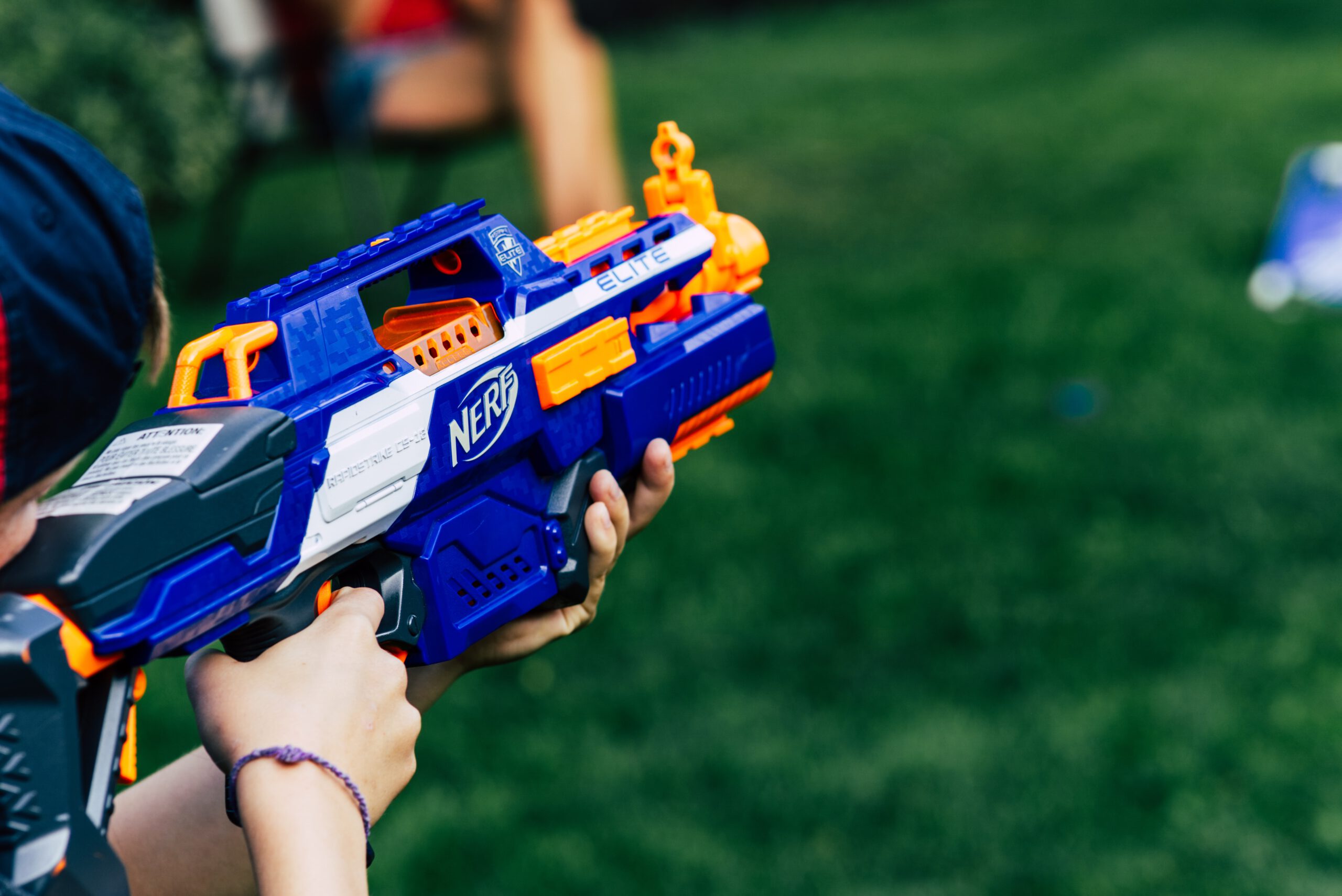
It is very likely that many of us at some point will have to shop for children’s presents, for example for a birthday or holiday. As we walk down the toy aisle, we will soon notice some toys tell a story of conflict. Swords, shields, guns and tanks are ready to entertain the imagination of small children. As adults who value peace and cooperation, hoping to pass these values on to the young generations, we may ask ourselves what role ‘war play’ plays in children’s development. Is it just a harmless way of self-expression? Could it have any negative impact on behavior or, on the contrary, could it be useful in any way?
It is very likely that many of us at some point will have to shop for children’s presents, for example for a birthday or holiday. As we walk down the toy aisle, we will soon notice some toys tell a story of conflict. Swords, shields, guns and tanks are ready to entertain the imagination of small children. As adults who value peace and cooperation, hoping to pass these values on to the young generations, we may ask ourselves what role ‘war play’ plays in children’s development. Is it just a harmless way of self-expression? Could it have any negative impact on behavior or, on the contrary, could it be useful in any way?

Photo by Kolby Milton

Photo by Kolby Milton
Even though it may seem superficial, play is undeniably essential for development. Playful activities hide deeper meanings and shape the development of important capacities like problem-solving, decision-making, language, creativity, or social skills (Burriss & Tsao, 2002). Pretend play in particular was shown to be valuable for supporting divergent thinking, school achievement (Wallance & Russ, 2015), and cognitive and emotional regulation (Slot, Mulder, Verhagen & Leseman, 2015). War play is a type of pretend play, but its content is about conflict and violence. The question that arises is whether there are negative effects of war play on the behavior of children which potentially offset the benefits that pretend play has in general. In other words, are there reasons to discourage this type of play?
Before looking at the behavioral consequences of war play, it is worth mentioning that both parents’ attitudes towards such play and media exposure are involved in the extent to which children practice it. Through a survey of Western European parents’ attitudes, Costabile et al. (1992) found varying opinions about war play at home: not approving it and not buying toy guns, not approving but not discouraging it, being unsure or believing it is a natural behavior and even joining the play. However, when it comes to school settings, there was a consensus that war-related toys should not be allowed, as they do not match with the values that they would like their children to adopt. Furthermore, parental attitudes, television programmes, and the play choices of peers and siblings seem to be influencing children’s play type selection. It has been observed that boys engage in more war play than girls (Costabile et al., 1992). This might be because of the kind of choices parents make when buying presents, or because of the different media programmes that boys and girls watch. In line with these observations, Coyne et al. (2014) found that viewing superhero programs lead to more gunplay for both boys and girls, although boys were more likely to watch such programs in the first place. The same authors also investigated how parents’ active mediation influences the effect of superhero programs. Active mediation means that the parent tries to help the child understand the content of what he or she is watching, for instance by discussing which behaviors are desirable and what should be learned from the fictional story of the superheroes. Interestingly, active mediation did not decrease war play and, on the contrary, even increased it for girls. This seems to suggest that exposure and accessibility towards examples of fantasy combat situations encourage children to adopt these behaviors in their play.
“authors seem to suggest is that children understand the distinction between the realm of play and reality, so they would not carry-over those combat-related behaviors in their daily interactions”
When it comes to the impact of war play on children’s behavior, opinions are divided. In their literature review on war play and aggression, Malloy and McMurray-Schwarz (2004) talk about two theories that generally dominate the field. On one hand, it was argued that it is healthy for children to explore feelings of power and control, learn to self-regulate, and understand the distinction between a game and reality through war play. Some researchers consider that children who engage in pretend war play and play with war toys usually do not have the purpose of harming each other and often sustained injuries are simply due to the nature of the activity. Hart and Nagel (2017) have found support that prohibiting children’s playful aggression can be harmful to their development since playful aggression helps stimulate cognitive, social, and communicative skills. The theory that depriving children of play fighting leads to deficits in children’s social, emotional, and physical development has also been supported in an earlier study by Hart and Tannock (2013). They also defined play fighting as involving communication and cooperation with no real intent to harm. This type of play can include war toys (such as guns and swords) and war play. There is an important distinction between the definition of aggression, which states aggressive behaviour entails a desire to hurt someone (Smith, Mackie, & Claypool, 2015), and Hart and Tannock’s (2013) definition of play fighting. What these authors seem to suggest is that children understand the distinction between the realm of play and reality, so they would not carry-over those combat-related behaviors in their daily interactions. Fehr and Russ (2013) have also studied and confirmed that aggression in pretend play is not indicative of actual, physical aggression and is actually related to prosocial behaviour in classrooms. On the basis of these findings, it seems that war play and the use of war toys are not only advantageous but also necessary for children’s development.
In contrast, Malloy and McMurray-Schwarz (2004) also reviewed a series of studies that argued that war play should be discouraged because it might teach children that aggression is an efficient way to solve conflicts and that aggression in social interactions is acceptable. In support of this, desensitization theory (Wople, 1973) states that more exposure to violence leads to a decrease in aversive responses to aggression. In line with this, Turner and Goldsmith (1976) found children who were given more aggression-related toys, like toy guns, would then express themselves with higher rates of antisocial behaviour, compared to children who were given non-aggression-related toys, like toy airplanes. Hart and Tannock (2013) explain that children who display higher rates of antisocial behaviour engage in more aggressive acts during pretend play, which does show that real-life behavior and behavior during play are not completely unrelated. Furthermore, Dunn and Hughes (2001) found that hard-to-manage children who engage in more violent fantasies in pretend play showed higher antisocial behaviour, poorer communication and coordination of play, and engaged in more aggression and conflict with friends. These findings suggest that war play might positively correlate with antisocial behaviour in children, but this effect might also interact with their personality traits.
“each child’s case should be examined individually before determining the type of play therapy”
Although it is still under debate exactly how spontaneous war play might influence children’s behavior, such play is currently used in therapy and thus, in a controlled way. War play in therapy has been beneficial in helping children understand their emotions. Young children are often puzzled as to what emotions are and how to express them in a healthy manner. Landreth (2002) states children often internalize their emotions and still lack the proper self-expression skills, necessary to convey what their feelings are. The use of war play in therapy is based on the idea that children must be guided and aided to express and release these internalized feelings. Kool and Lawver (2010) state that toys, defined as ‘aggressive’, such as toy guns, swords, and nerf darts promote the release of anger and irritability during the therapy session. However, the researchers warn that these toys require more stringent limit settings due to the higher destructive element they contain. Such therapy only applies to settings where a mental health professional is present and there is a clear therapeutic goal, assigned accordingly to the specific child’s case. This has also been confirmed by Laue (2015), stating a child’s background is crucial to consider before administering toy guns in play therapy. In addition, Kottman (2011) argued toy guns are not an ‘all-or-nothing’ approach and rather each child’s case should be examined individually before determining the type of play therapy. These findings support the theory that more aggression-related toys and play fighting might still benefit children, as long as they are appropriately selected and regulated by the therapist. The individual child’s development must therefore be considered before play therapy is prescribed. In other words, this does not mean that in daily life children play as soldiers to release anger or that suggesting war play would help a child manage his or her emotions at home.
“research in this area seems to be rather limited and outdated - most studies on this topic were conducted in the ’90s”
All in all, should you buy that sword for a birthday present? Before taking a decision, it is important to keep in mind that there are some limitations in previous research on this topic. Firstly, research in this area seems to be rather limited and outdated – most studies on this topic were conducted in the ’90s (when there was less methodological rigour compared to the present) and, with the recent focus on the effect of violent video games, less attention is paid to actual offline playing with guns and war scenarios. Moreover, very little is known about children’s personality characteristics, like agreeableness, self-regulation or neuroticism, and how they might be a mediating factor in war play and display of actual aggressive behaviour. We cannot know if children who already have aggressive tendencies are more attracted to war play or if war play could make children more aggressive. We also do not know how war play affects their attitude about conflict later in life. Importantly, another missing puzzle piece is how children understand pretense war play at different ages – what do they take from it? Furthermore, research is often contradicting, which might stem from the way researchers define terms like play fighting, war play, playful aggression. In addition, previous research generally lacks longitudinal studies. It is therefore unknown how play fighting might influence individuals in their adulthood and whether it has long-term consequences on their development.
For now, this discussion gives us food for thought – what is your stance on the matter? While writing this article, we (the authors) asked ourselves how we see war play in light of what is considered acceptable by society and whatnot. We, therefore, propose a thought experiment. Think of behaviors that you consider morally unacceptable or that are against values that you cherish. Would you have a different attitude if children engaged in such behaviors in pretend play? In addition, would your opinion change (and how) depending on gender? <<
References
-Burriss, K. G., & Tsao, L. L. (2002). Review of research: How much do we know about the importance of play in child development?. Childhood Education, 78(4), 230-233.
-Costabile, A., Genta, M. L., Zucchini, E., Smith, P. K., & Harker, R. (1992). Attitudes of parents toward war play in young children. Early Education and Development, 3(4), 356-369.
-Coyne, S. M., Linder, J. R., Rasmussen, E. E., Nelson, D. A., & Collier, K. M. (2014). It’sa bird! It’sa plane! It’sa gender stereotype!: Longitudinal associations between superhero viewing and gender stereotyped play. Sex Roles, 70(9-10), 416-430.
-Dunn, J., & Hughes, C. (2001). “I got some swords and you’re dead!”: Violent fantasy, antisocial behavior, friendship, and moral sensibility in young children. Child development, 72(2), 491-505.
-Fehr, K. K., & Russ, S. W. (2013). Aggression in pretend play and aggressive behavior in the classroom. Early Education and Development, 24(3), 332–345.
-Hart, J. L., & Tannock, M. T. (2013). Young children’s play fighting and use of war toys. Encyclopedia on early childhood development, 1-6.
-Hart, J. L., & Nagel, M. C. (2017). Including playful aggression in early childhood curriculum and pedagogy. Australasian journal of early childhood, 42(1), 41-48.
-Kool, R., & Lawver, T. (2010). Play therapy: Considerations and applications for the practitioner. Psychiatry (Edgmont), 7(10), 19.
-Kottman, T. (2011). Play therapy: Basics and beyond (2nd ed.). Alexandria, VA: American Counseling Association.
-Landreth, G. L. (2002). Therapeutic limit setting in the play therapy relationship. Professional psychology: Research and practice, 33(6), 529.
-Hart, J. L., & Nagel, M. C. (2017). Including Playful Aggression in Early Childhood Curriculum and Pedagogy. Australasian Journal of Early Childhood, 42(1), 41–48.
-Slot, P. L., Mulder, H., Verhagen, J., & Leseman, P. P. (2017). Preschoolers’ cognitive and emotional self‐regulation in pretend play: Relations with executive functions and quality of play. Infant and Child Development, 26(6), e2038.
-Smith, E. R., Mackie, D. M., & Claypool, H. M. (2015). Social psychology (4th ed.). Psychology Press.
-Wallace, C. E., & Russ, S. W. (2015). Pretend play, divergent thinking, and math achievement in girls: A longitudinal study. Psychology of Aesthetics, Creativity, and the Arts, 9(3), 296.
-Wolpe, J. (1973). The practice of behavior therapy.
Even though it may seem superficial, play is undeniably essential for development. Playful activities hide deeper meanings and shape the development of important capacities like problem-solving, decision-making, language, creativity, or social skills (Burriss & Tsao, 2002). Pretend play in particular was shown to be valuable for supporting divergent thinking, school achievement (Wallance & Russ, 2015), and cognitive and emotional regulation (Slot, Mulder, Verhagen & Leseman, 2015). War play is a type of pretend play, but its content is about conflict and violence. The question that arises is whether there are negative effects of war play on the behavior of children which potentially offset the benefits that pretend play has in general. In other words, are there reasons to discourage this type of play?
Before looking at the behavioral consequences of war play, it is worth mentioning that both parents’ attitudes towards such play and media exposure are involved in the extent to which children practice it. Through a survey of Western European parents’ attitudes, Costabile et al. (1992) found varying opinions about war play at home: not approving it and not buying toy guns, not approving but not discouraging it, being unsure or believing it is a natural behavior and even joining the play. However, when it comes to school settings, there was a consensus that war-related toys should not be allowed, as they do not match with the values that they would like their children to adopt. Furthermore, parental attitudes, television programmes, and the play choices of peers and siblings seem to be influencing children’s play type selection. It has been observed that boys engage in more war play than girls (Costabile et al., 1992). This might be because of the kind of choices parents make when buying presents, or because of the different media programmes that boys and girls watch. In line with these observations, Coyne et al. (2014) found that viewing superhero programs lead to more gunplay for both boys and girls, although boys were more likely to watch such programs in the first place. The same authors also investigated how parents’ active mediation influences the effect of superhero programs. Active mediation means that the parent tries to help the child understand the content of what he or she is watching, for instance by discussing which behaviors are desirable and what should be learned from the fictional story of the superheroes. Interestingly, active mediation did not decrease war play and, on the contrary, even increased it for girls. This seems to suggest that exposure and accessibility towards examples of fantasy combat situations encourage children to adopt these behaviors in their play.
“authors seem to suggest is that children understand the distinction between the realm of play and reality, so they would not carry-over those combat-related behaviors in their daily interactions”
When it comes to the impact of war play on children’s behavior, opinions are divided. In their literature review on war play and aggression, Malloy and McMurray-Schwarz (2004) talk about two theories that generally dominate the field. On one hand, it was argued that it is healthy for children to explore feelings of power and control, learn to self-regulate, and understand the distinction between a game and reality through war play. Some researchers consider that children who engage in pretend war play and play with war toys usually do not have the purpose of harming each other and often sustained injuries are simply due to the nature of the activity. Hart and Nagel (2017) have found support that prohibiting children’s playful aggression can be harmful to their development since playful aggression helps stimulate cognitive, social, and communicative skills. The theory that depriving children of play fighting leads to deficits in children’s social, emotional, and physical development has also been supported in an earlier study by Hart and Tannock (2013). They also defined play fighting as involving communication and cooperation with no real intent to harm. This type of play can include war toys (such as guns and swords) and war play. There is an important distinction between the definition of aggression, which states aggressive behaviour entails a desire to hurt someone (Smith, Mackie, & Claypool, 2015), and Hart and Tannock’s (2013) definition of play fighting. What these authors seem to suggest is that children understand the distinction between the realm of play and reality, so they would not carry-over those combat-related behaviors in their daily interactions. Fehr and Russ (2013) have also studied and confirmed that aggression in pretend play is not indicative of actual, physical aggression and is actually related to prosocial behaviour in classrooms. On the basis of these findings, it seems that war play and the use of war toys are not only advantageous but also necessary for children’s development.
In contrast, Malloy and McMurray-Schwarz (2004) also reviewed a series of studies that argued that war play should be discouraged because it might teach children that aggression is an efficient way to solve conflicts and that aggression in social interactions is acceptable. In support of this, desensitization theory (Wople, 1973) states that more exposure to violence leads to a decrease in aversive responses to aggression. In line with this, Turner and Goldsmith (1976) found children who were given more aggression-related toys, like toy guns, would then express themselves with higher rates of antisocial behaviour, compared to children who were given non-aggression-related toys, like toy airplanes. Hart and Tannock (2013) explain that children who display higher rates of antisocial behaviour engage in more aggressive acts during pretend play, which does show that real-life behavior and behavior during play are not completely unrelated. Furthermore, Dunn and Hughes (2001) found that hard-to-manage children who engage in more violent fantasies in pretend play showed higher antisocial behaviour, poorer communication and coordination of play, and engaged in more aggression and conflict with friends. These findings suggest that war play might positively correlate with antisocial behaviour in children, but this effect might also interact with their personality traits.
“each child’s case should be examined individually before determining the type of play therapy”
Although it is still under debate exactly how spontaneous war play might influence children’s behavior, such play is currently used in therapy and thus, in a controlled way. War play in therapy has been beneficial in helping children understand their emotions. Young children are often puzzled as to what emotions are and how to express them in a healthy manner. Landreth (2002) states children often internalize their emotions and still lack the proper self-expression skills, necessary to convey what their feelings are. The use of war play in therapy is based on the idea that children must be guided and aided to express and release these internalized feelings. Kool and Lawver (2010) state that toys, defined as ‘aggressive’, such as toy guns, swords, and nerf darts promote the release of anger and irritability during the therapy session. However, the researchers warn that these toys require more stringent limit settings due to the higher destructive element they contain. Such therapy only applies to settings where a mental health professional is present and there is a clear therapeutic goal, assigned accordingly to the specific child’s case. This has also been confirmed by Laue (2015), stating a child’s background is crucial to consider before administering toy guns in play therapy. In addition, Kottman (2011) argued toy guns are not an ‘all-or-nothing’ approach and rather each child’s case should be examined individually before determining the type of play therapy. These findings support the theory that more aggression-related toys and play fighting might still benefit children, as long as they are appropriately selected and regulated by the therapist. The individual child’s development must therefore be considered before play therapy is prescribed. In other words, this does not mean that in daily life children play as soldiers to release anger or that suggesting war play would help a child manage his or her emotions at home.
“research in this area seems to be rather limited and outdated - most studies on this topic were conducted in the ’90s”
All in all, should you buy that sword for a birthday present? Before taking a decision, it is important to keep in mind that there are some limitations in previous research on this topic. Firstly, research in this area seems to be rather limited and outdated – most studies on this topic were conducted in the ’90s (when there was less methodological rigour compared to the present) and, with the recent focus on the effect of violent video games, less attention is paid to actual offline playing with guns and war scenarios. Moreover, very little is known about children’s personality characteristics, like agreeableness, self-regulation or neuroticism, and how they might be a mediating factor in war play and display of actual aggressive behaviour. We cannot know if children who already have aggressive tendencies are more attracted to war play or if war play could make children more aggressive. We also do not know how war play affects their attitude about conflict later in life. Importantly, another missing puzzle piece is how children understand pretense war play at different ages – what do they take from it? Furthermore, research is often contradicting, which might stem from the way researchers define terms like play fighting, war play, playful aggression. In addition, previous research generally lacks longitudinal studies. It is therefore unknown how play fighting might influence individuals in their adulthood and whether it has long-term consequences on their development.
For now, this discussion gives us food for thought – what is your stance on the matter? While writing this article, we (the authors) asked ourselves how we see war play in light of what is considered acceptable by society and whatnot. We, therefore, propose a thought experiment. Think of behaviors that you consider morally unacceptable or that are against values that you cherish. Would you have a different attitude if children engaged in such behaviors in pretend play? In addition, would your opinion change (and how) depending on gender? <<



